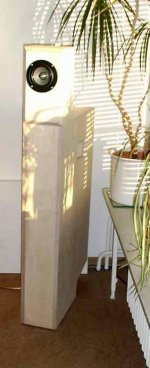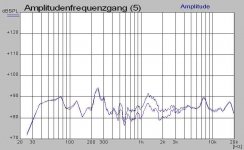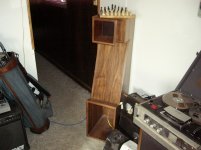Wanting to design a speaker enclosure(possibly horn loaded) with thermoformed corian using a full range driver- the budget per drive unit is up to £100 each; saw the bargain Dayton 4 inchers although I think I'm correct in that they are about 3.5 inch. These looked suitable but research says lots of distortion below 80hz. Are the Tangs a better bet? They are nearly twice the price now tho. Or should I just go for the excellent Jordan watts full range units?
Thanks in advance
Will
Thanks in advance
Will
My pick would be the same as Dave's, FE126 firstly, FE166 secondly. I have the FE126E in Saburo's and they sound fantastic if they have breathing room. Solid bass to 50-60Hz but my system uses two 12" Horn loaded subs below 100Hz so the Saburo's are High passed at 100Hz. This combo is very dynamic and can achieve quite surprising SPL levels with most music genres, heavy heavy metal being the acception.
FE 126 does look very good and the price in UK is about £50 each. Will see if any are going on ebay etc. Also digging the fact that they come in white because the cabinets will be white Corian approx 75 H x 50 W x 7.5 D cm (depth is not including the thermoformed horn throat, both front and back panels curved). Cabinets will lean back and be supported by a righ angled metal stand at the rear
"is it possible to successfully marry a front flared horn with a 'back' horn or TL using 1 full range driver? "
the bass won´t reach the mids.
Yes Alpair 10 looks perfect, proper full range, the graph looks smooth, almost too good to be true infact
Why can't the front flare look after the mids? ie using a spherical flare big enough to handle down to 150-175hz or so.
As a newbie I don't know if a rear folded design will handle the 150 -50 hz range and at the same time equal the same sound pressure levels as the front horn... but if so I have a compact cabinet idea(injection moulded) which can run a horn length max 3 metres with a throat area of about 0.80 metrs sq
Last edited:
As a newbie I don't know if a rear folded design will handle the 150 -50 hz range and at the same time equal the same sound pressure levels as the front horn... but if so I have a compact cabinet idea(injection moulded) which can run a horn length max 3 metres with a throat area of about 0.80 metrs sq
Ah, the compound horn. Many a man has gone insane with that one.
Scottmoose once pointed out that the front horn needs to be strategically used to fill in a dip in the overall response (i.e. where the forward radiation doesn't yet match up to the back horn, same as what a supra-baffle would do). So it's all completely dependent on the exact driver you choose, but at any rate, you'd be aiming at a very narrow bandwidth for that front horn (just where it's needed, no more)..
You are proposing a very big throat! Would that be the mouth?
Ah great, I didnt know it was called the compound horn. The design I have in mind would use a 100mm alpair 10 in a 180 hz front horn and the rear folded horn would be around 2.5m long (quarter wave). The floor firing horn opening (mouth!) is approx 10 sq ft on the drawings.
In my research I noticed that the Tannoy Westminster doesnt have a deep front flare at all.. why is this?
Also, is it ok to use an elliptical (top to bottom) front horn to save space?
In my research I noticed that the Tannoy Westminster doesnt have a deep front flare at all.. why is this?
Also, is it ok to use an elliptical (top to bottom) front horn to save space?
Last edited:
Bill, don´t go and design your own supermegawhatchamacallit - you´ll end up in tears. Size of what you can get away with depends on whether you are a married man. Plans are available in abundance here to whatever your needs and wants - and as to fun for your shillings, Fostexes are worth looking at.
Bill, don´t go and design your own supermegawhatchamacallit - you´ll end up in tears. Size of what you can get away with depends on whether you are a married man. Plans are available in abundance here to whatever your needs and wants - and as to fun for your shillings, Fostexes are worth looking at.
This is the DIY Audio forum and you are being discouraged from doing it yourself. A friend and I tried a few of the "well respected" designs, we were pleased with the results so we then moved on to learning the Hornresp program, Do a search you will find much information here about it) and designed our own horns, using the compound horn idea. Ignore the naysayers they tried it once and it didn't work and the idea that someone else may have success hurts their pride. Our own designs that we made blew away the plans that we followed and now the Bruce horns, and Frugal horns that we initially built are basically throw away designs compared to the results we have achieved designing ourselves. And once you hear a well designed compound horn (meeting the bass with the mids is not difficult at all. If you need any help shoot me a message) nothing else is even worth considering.
Hornresp seems daunting at first but once you read the entire help file it become very easy to use. A helpful tip in designing: the impulse response of the speaker is quite possibly the most important performance measurement there is. A ruler flat frequency response is basically meaningless because your room will screw that right up any way. So don't be discouraged and don't be afraid to experiment that's why we're here after all. This is a hobby not a lifelong decision.
And yes the Fostex drivers are fantastic! I personally recommend the FE206E. I could give you some suggestions for cabinet designs if you have an idea what size and/or frequency response you're looking for. IMNSHO most of the designs available on the net do not take very good advantage of these drivers potential. The compound horn design can give you clarity and dynamics you never dreamed possible in a loudspeaker.
Depending on baffle width, the rear horn has to be potentially 2x as efficient as the driver's forward radiation
It usually is anyway if you use Hornresp to maximize the efficiency. The Front horn then brings the midrange up to match and these types of drivers often have a rising efficiency in the high frequency to begin with. The front horn does not need to be very large. I have attached a photo of a compound horn speaker that my friend and I made so you could get an idea of the look you could get.
Attachments
- Status
- This old topic is closed. If you want to reopen this topic, contact a moderator using the "Report Post" button.
- Home
- Loudspeakers
- Full Range
- Best Full range drivers under £100 for a horn loaded cabinet?


